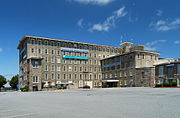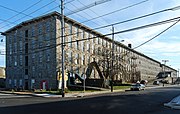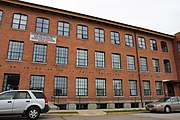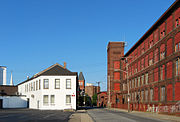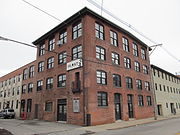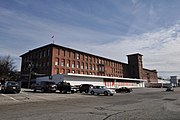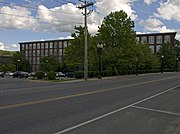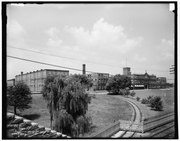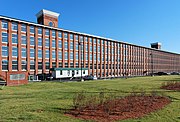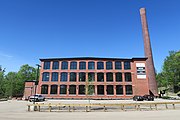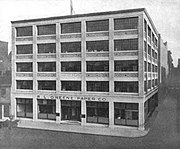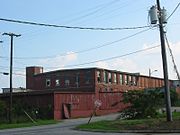User:JPRiley/Sheldon
| This is not a Wikipedia article: It is an individual user's work-in-progress page, and may be incomplete and/or unreliable. For guidance on developing this draft, see Wikipedia:So you made a userspace draft. Find sources: Google (books · news · scholar · free images · WP refs) · FENS · JSTOR · TWL |
Frank Perry Sheldon | |
|---|---|
 Frank P. Sheldon, circa 1911 | |
| Born | February 16, 1846 |
| Died | August 17, 1915 (aged 69) |
| Occupation | Mill engineer |

Frank P. Sheldon (1848-1915) was an American mill engineer based in Providence, Rhode Island.
Life and career
[edit]Frank Perry Sheldon was born February 16, 1846 in Providence, Rhode Island to Jeremiah Angell and Mary (Burbank) Sheldon. The attended the public schools of Providence, and after graduation from Providence High School attended courses in engineering at Scholfield's Commercial College. He first worked in the office of civil engineer Niles B. Schubarth, where he remained for about a year. He then worked as a draftsman for the American Screw Company in Providence and the machine shops of James S. Brown in Pawtucket. Brown soon recommended Sheldon to Foster H. Stafford, treasurer of the Union Mills of Fall River, Massachusetts. For Stafford Sheldon drew the plans of Union Mill No. 2. He then worked for Edward Kilburn, engineer of the Lonsdale Company at Lonsdale, Rhode Island. With Kilburn, in 1869 he designed Wamsutta Mill No. 4.[1]
After designing several mills, Sheldon established his own practice as a mill engineer in Providence. He gave his entire time to this business, gradually encompassing all areas of industrial engineering. From 1887 to 1896 his assistant was Dwight Seabury, who would practice mill engineering in Pawtucket from 1896.[2] He was a private practitioner until 1903, when he formed a partnership with his eldest son, Arthur Noyes Sheldon, [a] practicing as F. P. Sheldon & Company. In 1907 they were joined by his younger son, Frank Lawrence Sheldon, [b] and the firm name changed to F. P. Sheldon & Sons.[1] The firm practiced under that name until the elder Sheldon's death in 1915, his sons continued the firm under the name F. P. Sheldon & Son. Frank L. Sheldon died in 1925, but Arthur N. Sheldon continued to operate the firm under the same name until his retirement in 1964.[4]
Chief engineer of the firm after the death of Frank L. Sheldon was Wendell S. Brown,[c] who had that role in the firm from 1926 to 1940.[6]
Sheldon and his sons were often engaged in the research necessary to provide superior engineering services.[7]
Personal life
[edit]In 1900 Sheldon was appointed director of textiles to the United States Commission to the Exposition Universelle in Paris. He was also a member of the American Society of Mechanical Engineers and the National Cotton Manufacturers' Association.
Sheldon married in 1877 to Nellie Noyes. They had three children, two sons and one daughter. She died in 1883. He married again in 1892, to Mary Elizabeth Lincoln, but had no additional children.[1] Frank P. Sheldon died August 17, 1915, at the age of 69, in Providence.[8]
Legacy
[edit]In 1921 the firm published a retrospective, entitled A Half Century of Achievement, to commemorate the firm's fiftieth year of business.[9] This book also contained summaries of the firm's research. Research activities were covered more thouroughly in the 1926 publication Miscellaneous Scientific Papers of F. P. Sheldon & Son, comprising papers presented by members of the firm.[10]
In 1923 Sheldon & Son was recognized as one of the major mill engineering firms of the United States.[11]
Projects
[edit]- Union Mill No. 2, Fall River, Massachusetts (1867)[1]
- Wamsutta Mill No. 4, New Bedford, Massachusetts (1868-69)[1]
- King Philip Mill No. 1, Fall River, Massachusetts (1871-72, NRHP 1983, demolished 2018)[12]
- Berkeley Mill, Berkeley, Rhode Island (1872)[13]
- Grosvenor Dale Company Mill No. 2, North Grosvenor Dale, Connecticut (1872)[14]
- Beaver Dam Cotton Mills, Beaver Dam, Wisconsin (1881, NRHP 2011)[15]
- Slater Cotton Company New Mill, Pawtucket, Rhode Island (1881-82)[13]
- Providence Dyeing, Bleaching, Calendring Company Mills, Providence, Rhode Island (1885 et seq., NRHP 2004)[16]
- Ann and Hope Mill, Lonsdale, Rhode Island (1886 et seq.)[13]
- Berkshire Mill No. 1, Adams, Massachusetts (1889, NRHP 1982)[17]
- Gorham Manufacturing Company Factory, Providence, Rhode Island (1889-90 et seq., demolished 1997)[18]
- Cornell Mills, Fall River, Massachusetts (1890, NRHP 1983)[9]
- Warren Manufacturing Company Mills, Warren, Rhode Island (1896-98 et seq.)[13]
- Bourne Mills Weave Shed,[d] Tiverton, Rhode Island (1900, demolished 2005)[13]
- Pell City Manufacturing Company Mills, Pell City, Alabama (1902-03, burned and demolished 2008)[19]
- Ponemah Mill No. 3, Taftville, Connecticut (1902)[9]
- Greystone Mills, North Providence, Rhode Island (1904 et seq.)[20]
- Warwick Mills Weave Shed, West Warwick, Rhode Island (1906)[21]
- Brownell & Field Company Factory, Providence, Rhode Island (1907-08, demolished 2011)[9]
- Fitchburg Yarn Mill, Fitchburg, Massachusetts (1907 et seq., NRHP 2016)[22]
- Greenhalgh Mill, Pawtucket, Rhode Island (1907, burned 2003)[23]
- Herrick Building, Providence, Rhode Island (1908, demolished)[9]
- Whitehall Building, North Providence, Rhode Island (1911)[20]
- Davol Rubber Company Factory, Providence, Rhode Island (1913 et seq., NRHP 1980)[9]
- Gardner Building, Providence, Rhode Island (1914-15, altered 1925)[24]
- Pepperell Manufacturing Company Mill, Opelika, Alabama (1925-26, burned 2013)[25]
- Ponamah Mill Office Building, Taftville, Connecticut (1929)[26]
- Cranston Stadium, Cranston, Rhode Island (1935-39)[27]
Gallery of projects
[edit]-
King Philip Mill No. 1, Fall River, Massachusetts, 1871-72.
-
Berkeley Mill, Berkeley, Rhode Island, 1872.
-
Grosvenor Dale Company Mill No. 2, North Grosvenor Dale, Connecticut, 1872.
-
Slater Cotton Company New Mill, Pawtucket, Rhode Island, 1881-82.
-
Providence Dyeing, Bleaching, Calendring Company Mills, Providence, Rhode Island, 1885 et seq.
-
Ann and Hope Mill, Lonsdale, Rhode Island, 1886 et seq.
-
Gorham Manufacturing Company Factory, Providence, Rhode Island, 1889-90 et seq.
-
Greystone Mills, North Providence, Rhode Island, 1904 et seq.
-
Fitchburg Yarn Mill, Fitchburg, Massachusetts, 1907 et seq.
-
Davol Rubber Company Factory, Providence, Rhode Island, 1913 building.
-
Gardner Building, Providence, Rhode Island, 1914-15.
-
Pepperell Manufacturing Company Mill, Opelika, Alabama, 1925-26.
Notes
[edit]- ^ Arthur Noyes Sheldon was born December 27, 1878 in Providence. He was educated at English High School in Providence and Harvard University, graduating in 1899, after which he went to work in his father's office.[3] He died April 16, 1973 in Cranston, Rhode Island.[4]
- ^ Frank Lawrence Sheldon was born August 1, 1883 in Providence. He was educated at Riverview Military Academy in Poughkeepsie and the Rensselaer Polytechnic Institute, after which he went to work in his father's office. He died June 22, 1925 in Providence.[5]
- ^ Wendell Stimpson Brown was born February 22, 1889 in Providence to Charles Henry and Isadora Lizette (Stimpson) Brown. He attended Brown University, graduating in 1911, and immediately joined Sheldon & Sons. He became an engineer in 1914. After leaving Sheldon & Son he joined C. A. Maguire & Associates. He died March 23, 1966.[6]
- ^ Possibly the earliest example of a saw-tooth roof in Rhode Island.
References
[edit]- ^ a b c d e "Frank Perry Sheldon" in Lamb's Textile Industries of the United States, vol. 1, ed. John Howard Brown and E. N. Morris (Boston: James H. Lamb Company, 1911): 383-384.
- ^ "Dwight Seabury" in Lamb's Textile Industries of the United States, vol. 1, ed. John Howard Brown and E. N. Morris (Boston: James H. Lamb Company, 1911): 392.
- ^ Secretary's Fourth Report, Harvard College Class of 1899 (Quincy: Harvard College Class of 1899, 1914)
- ^ a b "Deaths," Brown Alumni Monthly 73, no. 9 (July 1973): 49.
- ^ "Obituary," Textile World 68, no. 1 (July 4 1925): 155.
- ^ a b "Brown, Wendell Stimpson" in The National Cyclopaedia of American Biography, vol. 55 (New York: James T. White & Company, 1967): 284
- ^ Betsy Hunter Bradley, The Works: The Industrial Architecture of the United States (New York and Oxford: Oxford University Press, 1999): 19.
- ^ "Obituary," American Wool and Cotton Reporter 29, no. 35 (September 2 1915): 1316.
- ^ a b c d e f A Half Century of Achievement (Providence: F. P. Sheldon & Son, 1921)
- ^ "An Interesting Book," Cotton 91, no. 6 (April 1927): 609.
- ^ J. P. H. Perry, "Architects and Industrial Building," Concrete 23, no. 5 (November 1923): 189-191.
- ^ "FLR.AA". mhc-macris.net. Massachusetts Historical Commission, n. d. Accessed June 12, 2021.
- ^ a b c d e William H. Jordy, Buildings of Rhode Island (New York and Oxford: Oxford University Press, 2004)
- ^ North Grosvenordale Mill Historic District NRHP Registration Form (1993)
- ^ Paramount Knitting Company Mill NRHP Registration Form (2011)
- ^ Providence Dyeing, Bleaching, Calendring Company NRHP Registration Form (2004)
- ^ "ADA.516". mhc-macris.net. Massachusetts Historical Commission, n. d. Accessed June 12, 2021.
- ^ Providence Industrial Sites: Statewide Historic Preservation Report P-P-6 (Providence: Rhode Island Historical Preservation Commission, 1981): 45.
- ^ Avondale Mill Historic District NRHP Registration Form (2000)
- ^ a b Greystone Historic District NRHP Registration Form (2008)
- ^ Historic and Architectural Resources of West Warwick, Rhode Island: A Preliminary Report (Providence: Rhode Island Historical Preservation Commission, 1987): 53.
- ^ "FIT.AB". mhc-macris.net. Massachusetts Historical Commission, n. d. Accessed June 12, 2021.
- ^ Pawtucket, Rhode Island: Statewide Historical Preservation Report P-PA-2 (Providence, RI: Rhode Island Historical Preservation Commission, 1978): 59.
- ^ Iron Trade Review 55, no. 22 (November 26 1914): 1010.
- ^ "Mill News," Textile World 67, no. 12 (March 21 1925): 75.
- ^ "News About Mills," Textile World 77, no. 1 (January 4 1930): 74.
- ^ Cranston, Rhode Island: Statewide Historical Preservation Report P-C-1 (Providence: Rhode Island Historical Preservation Commission, 1980): 68.


